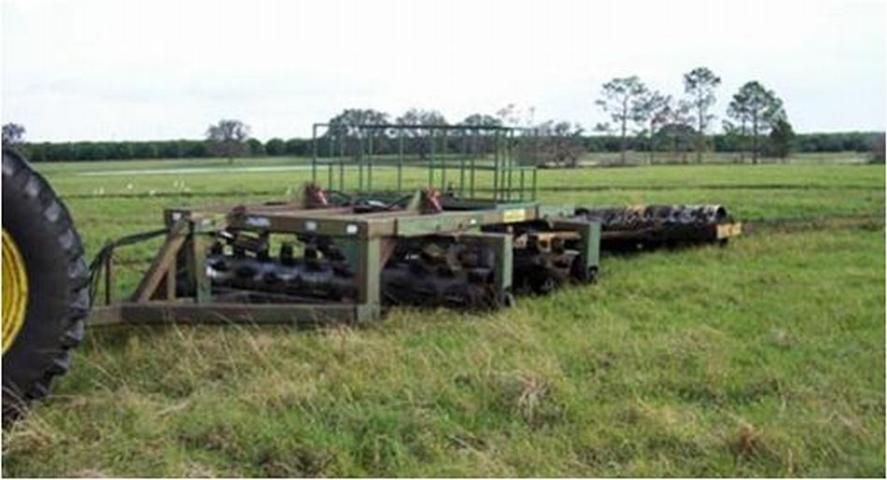Aeration—a process by which soil is mechanically disturbed—is commonly used to renovate established pastures with the objective of increasing forage production. Aerator machines include coulters, which make narrow slits in the soil, rollers with spikes that make indentations in the soil, and prongs, which function like a mini-subsoiler. These machines can also be used for purposes other than pasture aeration, such as for weed control and for incorporating fertilizer, lime or seeds of annual, cool-season forages. Research conducted in South Florida observed that pasture aeration may decrease the number of smutgrass clumps by 80% (Rana et al., 2015).
Although the main objective of aerating pastures is to reduce soil compaction and increase water infiltration, it is unlikely that soil physical problems will occur in areas of pastureland in Florida. Instead, soil compaction is most likely to occur in areas of continuous and intense traffic of heavy machines or in heavy-texture clay soils, but this is not a common situation in pastures and hayfields in Florida. In addition, well managed, established pastures often exhibit dense root systems, which can prevent soil compaction.

Credit: Brantley Ivey
After long periods of drought, the surface of the soil becomes apparently harder, and sometimes this situation is confounded with soil compaction. The apparent "hardness" of the soil surface after prolonged dry periods is a natural characteristic of the soil, also known as soil aggregation, and is not expected to have detrimental effects on forage production. After soil moisture is restored, due to rainfall or irrigation, soil often returns to its adequate physical condition.
Testing for soil compaction may be done with a penetrometer. However, because penetrometer values are highly affected by soil moisture, any determination regarding soil compaction should also be based on visual observation of the forage root system, including consideration of whether the roots' growth is restricted, as well as consideration of soil moisture and changes in soil density.
Pasture aeration can also result in a fast "green up" of forage; when soil is disturbed, it releases organic matter and nutrients to the plants. However, the benefits of the nutrients released after aeration are only temporary and are not expected to improve forage production in the long run.
The question, therefore, remains; does pasture aeration increase forage production? Several studies with different types of aerators have been conducted in different states, and the results of these studies were quite variable.
Research at the UF/IFAS Range Cattle Research and Education Center in Ona, FL, tested the efficiency of aeration in increasing forage production. The study was conducted on a typical, poorly drained flatwoods soil (Ona fine sand and Pomona fine sand), using a 13-year-old and 40-year-old Pensacola bahiagrass pasture. The 13-year-old bahiagrass pasture was aerated in 1991; the 40-year-old pasture was aerated in 1992. The machines tested were the Mardin HL-7 tandem chopper, Lawson 8'x16" multi-blade pasture aerator, and an Aerway model AW118 pasture aerator. In addition, a control area was not aerated.
Water infiltration rates and penetrometer values (compaction) were affected immediately after the treatment, but not at three, six, or 12 months after aeration. Soil moisture affected penetrometer values (a measure of soil compaction) for all aeration treatments. In this study, aeration did not increase bahiagrass yields of the 13-year-old pasture, and bahiagrass yields of the 40-year-old pasture were reduced after aeration (Table 1). These results indicate that, regardless of the aerator machine used, aeration has no benefits on bahiagrass production and, in some cases, can potentially reduce forage yields.
Research conducted in pastures established in "heavier" soil types showed similar results. In a two-year study in Mississippi on a silty and a sandy loam soil, researchers compared the effects of aerway, shank renovator, disk, deep chisel 10" and control (no aeration) on bahiagrass pastures and bermudagrass hayfields at different times of the year. None of the treatments had any positive effect on soil-penetration resistance, moisture, and forage yield.
Conclusions
It is unlikely that pasture aeration will increase water infiltration and forage production in sandy soils in Florida. If soil compaction is suspected, consider penetrometer, visual observation of root system, soil moisture and density information.
References
Kalmbacher, R. and M.J. Williams. 1993. Machine renovation of bahiagrass pastures. Ona Range Cattle REC Field Day Report RC 93-1. UF/IFAS, Ona, FL.
Ingram, D.M., P.E. David, R.E. Switzer, C.H. Hovermale, B. Johnson, and N.C. Edwards. Influence of spike-tooth aeration on permanent pastures in Mississippi. http://msucares.com/pubs/techbulletins/tb220.htm. Verified 01/08/2009.
Rana, N., B.A. Sellers, J.A. Ferrell, G.E. MacDonald, M.L. Silveira, and J.M. Vendramini. 2015. Integrated management techniques for long-term control of giant smutgrass (Sporobolus indicus var. pyramidalis) in bahiagrass pasture in Florida. Weed Technol. 29:570-577.